In almost all compositions a rhythmic flow of lines can be traced. Not necessarily a flow of actual lines (although these often exist); they may be only imaginary lines linking up or massing certain parts, and bringing them into conformity with the rhythmic conception of the whole. Or again, only a certain stress and flow in the forms, suggesting line movements. But these line movements flowing through your panel are of the utmost importance; they are like the melodies and subjects of a musical symphony, weaving through and linking up the whole composition.
Often, the line of a contour at one part of a picture is picked up again by the contour of some object at another part of the composition, and although no actual line connects them, a unity is thus set up between them. (See diagrams, pages 166 and 168, illustrating line compositions of pictures 145by Botticelli and Paolo Veronese). This imaginary following through of contours across spaces in a composition should always be looked out for and sought after, as nothing serves to unite a picture like this relationship of remote parts. The flow of these lines will depend on the nature of the subject: they will be more gracious and easy, or more vigorous and powerful, according to the demands of your subject.
This linking up of the contours applies equally well to the drawing of a single figure or even a head or hand, and the student should always be on the look out for this uniting quality. It is a quality of great importance in giving unity to a composition.
Parallelism
When groups of lines in a picture occur parallel to each other they produce an accentuation of the particular quality the line may contain, a sort of sustained effect, like a sustained chord on an organ, the effect of which is much bigger than that of the same chord struck staccato. This sustained quality has a wonderful influence in steadying and uniting your work.
This parallelism can only be used successfully with the simplest lines, such as a straight line or a simple curve; it is never advisable except in decorative patterns to be used with complicated shapes. Blake is very fond of the sustained effect parallelism gives, and uses the repetition of curved and straight lines very often in his compositions. Note in Plate I of the Job series, page 146 [Transcribers Note: Plate XXXI], the use made of this sustaining quality in the parallelism of the sheep's backs in the background and the parallel upward flow of the lines of the figures. In Plate II you see it used in the curved lines of the figures on either side of 146the throne above, and in the two angels with the scroll at the left-hand corner. Behind these two figures you again have its use accentuating by repetition the peaceful line of the hacks of the sheep. The same thing can be seen in Plate XXXI, B, where the parallelism of the back lines of the sheep and the legs of the seated figures gives a look of peace contrasting with the violence of the messenger come to tell of the destruction of Job's sons. The emphasis that parallelism gives to the music of particular lines is well illustrated in all Blake's work. He is a mine of information on the subject of line rhythm. Compare A with Plate XXXI, C; note how the emotional quality is dependent in both cases on the parallelism of the upward flow of the lines. How also in Plate I he has carried the vertical feeling even into the sheep in the front, introducing little bands of vertical shading to carry through the vertical lines made by the kneeling figures. And in the last plate, "So the Lord blessed the latter end of Job more than the beginning," note how the greater completeness with which the parallelism has been carried out has given a much greater emphasis to the effect, expressing a greater exaltation and peace than in Plate XXXI, A. Notice in Plate XXXI, D, where "The just, upright man is laughed to scorn," how this power of emphasis is used to increase the look of scorn hurled at Job by the pointing fingers of his three friends.
Of the use of this principle in curved forms, the repetition of the line of the back in stooping figures is a favourite device with Blake. There will be found instances of this in Plate XXXII, E and G. (Further instances will be found on reference 147to Plates VII, VIII, XIII, and XVII, in Blake's Job.) In the last instance it is interesting to note how he has balanced the composition, which has three figures kneeling on the right and only one on the left. By losing the outline of the third figure on the right and getting a double line out of the single figure on the left by means of the outline of the mass of hair, and also by shading this single figure more strongly, he has contrived to keep a perfect balance. The head of Job is also turned to the left, while he stands slightly on that side, still further balancing the three figures on the right. (This does not show so well in the illustration here reproduced as in the original print.)
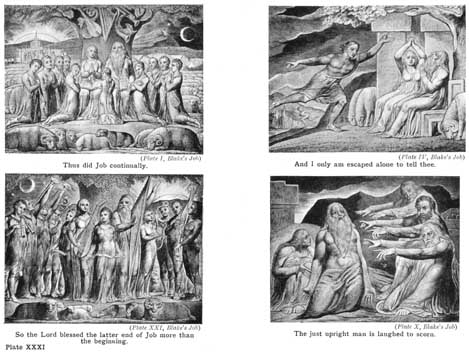
Plate XXXI.
Thus did Job continually. (Plate I, Blake's Job)
And I only am escaped alone to tell thee. (Plate IV, Blake's Job)
So the Lord blessed the latter end of Job more than the beginning. (Plate XXI, Blake's Job)
The just upright man is laughed to scorn. (Plate X, Blake's Job)
Some rude things were said above about the straight line and the circle, on account of their lack of variety, and it is true that a mathematically straight line, or a mathematically perfect circle, are never found in good artistic drawing. For without variety is no charm or life. But these lines possess other qualities, due to their maximum amount of unity, that give them great power in a composition; and where the expression of sublimity or any of the deeper and more profound sentiments are in evidence, they are often to be found.
The rows of columns in a Greek temple, the clusters of vertical lines in a Gothic cathedral interior, are instances of the sublimity and power they possess. The necessary play that makes for vitality—the "dither" as we called this quality in a former chapter—is given in the case of the Greek temple by the subtle curving of the lines of columns and steps, and by the rich variety of the sculpture, and in the case of the Gothic cathedral by a rougher cutting of the stone blocks and the variety in the 148colour of the stone. But generally speaking, in Gothic architecture this particular quality of "dither" or the play of life in all the parts is conspicuous, the balance being on the side of variety rather than unity. The individual workman was given a large amount of freedom and allowed to exercise his personal fancy. The capitals of columns, the cusping of windows, and the ornaments were seldom repeated, but varied according to the taste of the craftsman. Very high finish was seldom attempted, the marks of the chisel often being left showing in the stonework. All this gave a warmth and exuberance of life to a fine Gothic building that makes a classical building look cold by comparison. The freedom with which new parts were built on to a Gothic building is another proof of the fact that it is not in the conception of the unity of the whole that their chief charm consists.
On the other hand, a fine classic building is the result of one large conception to which every part has rigorously to conform. Any addition to this in after years is usually disastrous. A high finish is always attempted, no tool marks nor any individuality of the craftsman is allowed to mar the perfect symmetry of the whole. It may be colder, but how perfect in sublimity! The balance here is on the side of unity rather than variety.
The strength and sublimity of Norman architecture is due to the use of circular curves in the arches, combined with straight lines and the use of square forms in the ornaments—lines possessed of least variety.
All objects with which one associates the look of strength will be found to have straight lines in their composition. The look of strength in a strong 149man is due to the square lines of the contours, so different from the rounded forms of a fat man. And everyone knows the look of mental power a square forehead gives to a head and the look of physical power expressed by a square jaw. The look of power in a rocky landscape or range of hills is due to the same cause.

Plate XXXII.
When the Almighty was yet with me, when my children were about me. (Plate II, Blake's Job)
With dreams upon my bed Thou scarest me, and affrightest me with visions. (Plate XI, Blake's Job)
Printed the wrong way up in order to show that the look of horror is not solely dependent on the things represented but belongs to the rhythm, the pattern of the composition.
And my servant Job shall pray for you. (Plate XVIII, Blake's Job)
When the morning-stars sang together, and all the sons of God shouted for joy. (Plate XIV, Blake's Job)
The Horizontal and the Vertical
The horizontal and the vertical are two very important lines, the horizontal being associated with calm and contemplation and the vertical with a feeling of elevation. As was said above, their relation to the sides of the composition to which they are parallel in rectangular pictures is of great importance in uniting the subject to its bounding lines and giving it a well-knit look, conveying a feeling of great stability to a picture.
How impressive and suggestive of contemplation is the long line of the horizon on a calm day at sea, or the long, horizontal line of a desert plain! The lack of variety, with all the energy and vitality that accompany it, gives one a sense of peace and rest, a touch of infinity that no other lines can convey. The horizontal lines which the breeze makes on still water, and which the sky often assumes at sunset, affect us from the same harmonic cause.
The stone pine and the cypress are typical instances of the sublime associated with the vertical in nature. Even a factory chimney rising above a distant town, in spite of its unpleasant associations, is impressive, not to speak of the beautiful spires of some of our Gothic cathedrals, pointing upwards. How well Constable has used the vertical sublimity of the spire of Salisbury Cathedral can be seen in his picture, at the Victoria and Albert Museum, where he has contrasted it with the gay tracery of an arch 150of elm trees. Gothic cathedrals generally depend much on this vertical feeling of line for their impressiveness.
The Romans knew the expressive power of the vertical when they set up a lonely column as a monument to some great deed or person. And a sense of this sublimity may be an unconscious explanation of the craze for putting towers and obelisks on high places that one comes across in different parts of the country, usually called someone's "folly."
In the accompanying diagrams, A, B, C and D, E, F, pages 152 [Transcribers Note: Diagram X] and 153 [Transcribers Note: Diagram XI], are examples of the influence to be associated with the horizontal and vertical lines. A is nothing but six straight lines drawn across a rectangular shape, and yet I think they convey something of the contemplative and peaceful sense given by a sunset over the sea on a calm evening. And this is entirely due to the expressive power straight lines possess, and the feelings they have the power to call up in the mind. In B a little more incident and variety has been introduced, and although there is a certain loss of calm, it is not yet enough to destroy the impression. The line suggesting a figure is vertical and so plays up to the same calm feeling as the horizontal lines. The circular disc of the sun has the same static quality, being the curve most devoid of variety. It is the lines of the clouds that give some excitement, but they are only enough to suggest the dying energy of departing day.
Now let us but bend the figure in a slight curve, as at C, and destroy its vertical direction, partly cover the disc of the sun so as to destroy the complete circle, and all this is immediately altered, our 151calm evening has become a windy one, our lines now being expressive of some energy.
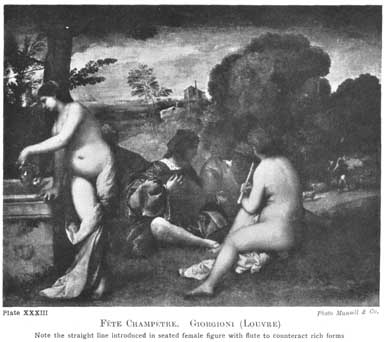
PLATE XXXIII.
FêTE CHAMPêTRE. GIORGIONI (LOUVRE)
Note the straight line introduced in seated female figure with flute to counteract rich forms.
To take a similar instance with vertical lines. Let D represent a row of pine trees in a wide plain. Such lines convey a sense of exaltation and infinite calm. Now if some foliage is introduced, as at E, giving a swinging line, and if this swinging line is carried on by a corresponding one in the sky, we have introduced some life and variety. If we entirely destroy the vertical feeling and bend our trees, as at F, the expression of much energy will be the result, and a feeling of the stress and struggle of the elements introduced where there was perfect calm.
It is the aloofness of straight lines from all the fuss and flurry of variety that gives them this calm, infinite expression. And their value as a steadying influence among the more exuberant forms of a composition is very great. The Venetians knew this and made great use of straight lines among the richer forms they so delighted in.
It is interesting to note how Giorgione in his "Fête Champêtre" of the Louvre (see illustration, page 151 [Transcribers Note: Plate XXXIII]), went out of his way to get a straight line to steady his picture and contrast with the curves. Not wanting it in the landscape, he has boldly made the contour of the seated female conform to a rigid straight line, accentuated still further by the flute in her hand. If it were not for this and other straight lines in the picture, and a certain squareness of drawing in the draperies, the richness of the trees in the background, the full forms of the flesh and drapery would be too much, and the effect become sickly, if not positively sweet. Van Dyck, also, used to go out of his way to introduce a hard straight line near the head in his portraits for the same 154reason, often ending abruptly, without any apparent reason, a dark background in a hard line, and showing a distant landscape beyond in order to get a light mass to accentuate the straight line.
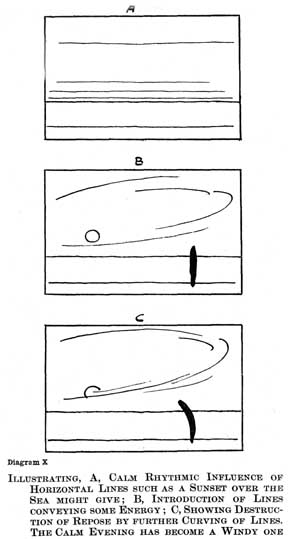
Diagram X.
ILLUSTRATING, A, CALM RHYTHMIC INFLUENCE OF HORIZONTAL LINES SUCH AS A SUNSET OVER THE SEA MIGHT GIVE; B, INTRODUCTION OF LINES CONVEYING SOME ENERGY; C, SHOWING DESTRUCTION OF REPOSE BY FURTHER CURVING OF LINES. THE CALM EVENING HAS BECOME A WINDY ONE.
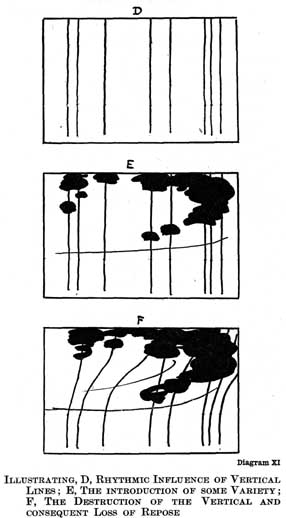
Diagram XI.
ILLUSTRATING, D, RHYTHMIC INFLUENCE OF VERTICAL LINES; E, THE INTRODUCTION OF SOME VARIETY; F, THE DESTRUCTION OF THE VERTICAL AND CONSEQUENT LOSS OF REPOSE.
The rich modelling and swinging lines of the "Bacchus and Ariadne" of Titian in the National Gallery, here reproduced, page 154 [Transcribers Note: Plate XXXIV], would be too gross, were it not for the steadying influence of the horizontal lines in the sky and the vertical lines of the tree-trunks.
While speaking of this picture, it might not be out of place to mention an idea that occurred to me as to the reason for the somewhat aggressive standing leg of the female figure with the cymbals leading the procession of revellers. I will not attempt any analysis of this composition, which is ably gone into in another book of this series. But the standing leg of this figure, given such prominence in the composition, has always rather puzzled me. I knew Titian would not have given it that vigorous stand without a good reason. It certainly does not help the run of the composition, although it may be useful in steadying it, and it is not a particularly beautiful thing in itself, as the position is one better suited to a man's leg than to a woman's. But if you cover it over with your finger and look at the composition without it, I think the reason of its prominence becomes plainer. Titian evidently had some trouble, as well he might have, with the forward leg of the Bacchus. He wished to give the look of his stepping from the car lightly treading the air, as gods may be permitted to do. But the wheel of the car that comes behind the foot made it difficult to evade the idea that he was stepping on it, which would be the way an ordinary mortal 155would alight. I think the duty of the aggressive standing leg of the leading Bacchante, with its great look of weight, is to give a look of lightness to this forward leg of Bacchus, by contrast—which it certainly does. On examining the picture closely in a good light, you will see that he has had the foot of Bacchus in several positions before he got it right. Another foot can distinctly be seen about a couple of inches or so above the present one. The general vertical direction of this leg is also against its look of lightness and motion, tending rather to give it a stationary, static look. I could not at first see why he did not bring the foot further to the right, which would have aided the lightness of the figure and increased its movement. But you will observe that this would have hurled the whole weight of the mass of figures on the right, forward on to the single figure of Ariadne, and upset the balance; as you can see by covering this leg with your finger and imagining it swinging to the right. So that Titian, having to retain the vertical position for Bacchus' forward leg, used the aggressive standing leg of the cymbal lady to accentuate its spring and lightness.
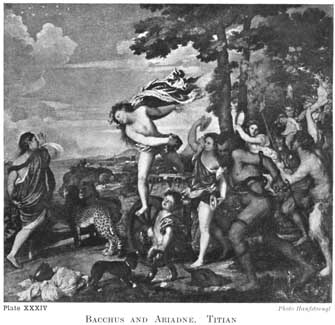
Plate XXXIV.
BACCHUS AND ARIADNE. TITIAN
Photo Hanfstaengl
A feeling of straight-up-ness in a figure or of the horizontal plane in anything will produce the same effect as a vertical or horizontal line without any actual line being visible. Blake's "Morning Stars Singing Together" is an instance of the vertical chord, although there is no actual upright line in the figures. But they all have a vigorous straight-up-ness that gives them the feeling of peace and elevation coupled with a flame-like line running through them that gives them their joyous energy.

Diagram XII.
A, B, C
The Right Angle
The combination of the vertical with the horizontal produces one of the strongest and most arresting 156chords that you can make, and it will be found to exist in most pictures and drawings where there is the expression of dramatic power. The cross is the typical example of this. It is a combination of lines that instantly rivets the attention, and has probably a more powerful effect upon the mind—quite apart from anything symbolised by it—than any other simple combinations that could have been devised. How powerful is the effect of a vertical figure, or even a post, seen cutting the long horizontal line of the horizon on the sea-shore. Or a telegraph post by the side of the road, seen against the long horizontal line of a hill at sunset. The look of power given by the vertical lines of a contracted brow is due to the same cause. The vertical furrows of the brow continuing the lines of the nose, make a continuous vertical which the horizontal lines of the brow cross (see Fig. A in the illustration). The same cause gives the profile a powerful look when the eyebrows make a horizontal line contrasting with the vertical line of the forehead (Fig. B). Everybody knows the look of power associated with a square brow: it is not that the square forehead gives the look of a larger brain capacity, for if the forehead protrudes in a curved line, as at C, the look of power is lost, although there is obviously more room for brains.
This power of the right angle is well exemplified in Watts' "Love and Death," here reproduced, page 158 [Transcribers Note: Plate XXXV]. 157In this noble composition, in the writer's opinion one of the most sublime expressions produced by nineteenth-century art, the irresistible power and majesty of the slowly advancing figure of Death is largely due to the right angle felt through the pose. Not getting it in the contour, Watts has boldly introduced it by means of shading the farther arm and insisting on the light upper edge of the outstretched arm and hand, while losing somewhat the, outline of the head beyond. Note also the look of power the insistence on square forms in the drapery gives this figure. The expression is still further emphasised by the hard square forms of the steps, and particularly by the strong horizontal line of the first step so insisted on, at right angles to the vertical stand of the figure; and also the upright lines of the doorway above. In contrast with the awful sublimity of this figure of Death, how touching is the expression of the little figure of Love, trying vainly to stop the inevitable advance. And this expression is due to the curved lines on which the action of the figure is hung, and the soft undulating forms of its modelling. Whereas the figure of Death is all square lines and flat crisp planes, the whole hanging on a dramatic right angle; this figure is all subtle fullness both of contour and modelling melting one into the other, the whole hung upon a rich full curve starting at the standing foot of the advancing figure. And whereas the expression of Death is supported and emphasised by the hard, square forms and texture of the stone steps, the expression of Love is supported and emphasised by the rounded forms and soft texture of the clustering roses. On this contrast of line and form, so in sympathy with the 159profound sentiment to which this picture owes its origin, the expressive power of this composition will be found to depend.
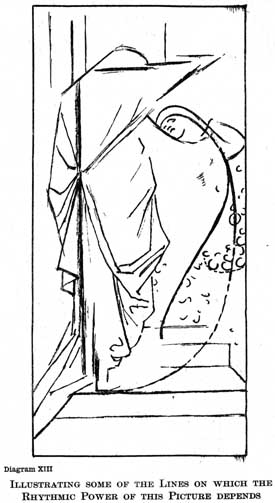
Diagram XIII.
ILLUSTRATING SOME OF THE LINES ON WHICH THE RHYTHMIC POWER OF THIS PICTURE DEPENDS.
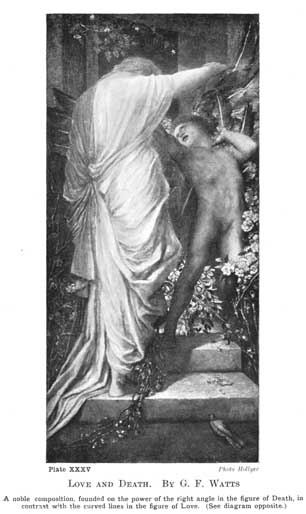
Plate XXXV.
LOVE AND DEATH. BY G.F. WATTS
A noble composition, founded on the power of the right angle in the figure of Death, in contrast with the curved lines in the figure of Love. (See diagram opposite.)
Photo Hollyer
In the diagram accompanying the reproduction of this picture I have tried to indicate in diagrammatical form some of the chief lines of its anatomy.
In these diagrams of the anatomy of compositions the lines selected are not always very obvious in the originals and are justly much broken into by truths of natural appearance. But an emotional significance depending on some arrangement of abstract lines is to be found underlying the expression in every good picture, carefully hidden as it is by all great artists. And although some apology is perhaps necessary for the ugliness of these diagrams, it is an ugliness that attends all anatomy drawings. If the student will trace them and put his tracing over the reproductions of the originals, they will help him to see on what things in the arrangement the rhythmic force of the picture depends.
Other lines, as important as those selected, may have been overlooked, but the ones chosen will suffice to show the general character of them all.
There is one condition in a composition, that is laid down before you begin, and that is the shape of your panel or canvas. This is usually a rectangular form, and all the lines of your design will have to be considered in relation to this shape. Vertical and horizontal lines being parallel to the boundaries of rectangular pictures, are always right and immediately set up a relationship, as we have seen.
The arresting power of the right angle exists at each corner of a rectangular picture, where the 160vertical sides meet the horizontal base, and this presents a difficulty, because you do not wish the spectator's attention drawn to the corners, and this dramatic combination of lines always attracts the eye. A favourite way of getting rid of this is to fill them with some dark mass, or with lines swinging round and carrying the eye past them, so that the attention is continually swung to the centre of the picture. For lines have a power of directing the attention, the eye instinctively running with them, and this power is of the greatest service in directing the spectator to the principal interest.
It is this trouble with the corners that makes the problem of filling a square so exacting. In an ordinary rectangular panel you have a certain amount of free space in the middle, and the difficulty of filling the corners comfortably does not present itself until this space is arranged for. But in a square, the moment you leave the centre you are in one or other of the corners, and the filling of them governs the problem much more than in the case of other shapes. It is a good exercise for students to give themselves a square to fill, in order to understand this difficulty and learn to overcome it.
Other lines that possess a direct relation to a rectangular shape are the diagonals. Many compositions that do not hang on a vertical or horizontal basis are built on this line, and are thus related to the bounding shape.
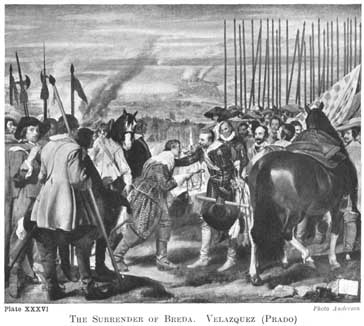
Plate XXXVI.
THE SURRENDER OF BREDA VELAZQUEZ (PRADO)
Photo Anderson
When vertical, horizontal, or diagonal lines are referred to, it must not be assumed that one means in all cases naked lines. There is no pure vertical line in a stone pine or cypress tree, nor pure horizontal 161 line in a stretch of country, but the whole swing of their lines is vertical or horizontal. And in the same way, when one speaks of a composition being hung upon a diagonal, it is seldom that a naked diagonal line exists in the composition, but the general swing is across the panel in harmony with one or other diagonal. And when this is so, there is a unity set up between the design and its boundaries. A good instance of vertical, horizontal, and diagonal lines to unite a picture is Velazquez's "The Surrender of Breda," here reproduced. Note the vertical chord in the spears on the left, continued in the leg of the horse and front leg of the figure receiving the key, and the horizontal line made by the dark mass of distant city, to be continued by the gun carried over the shoulder of the figure with the slouch hat behind the principal group. Velazquez has gone out of his way to get this line, as it could hardly have been the fashion to carry a gun in this position, pointing straight at the head of the man behind. Horizontal lines also occur in the sky and distant landscape, one running right through the group of spears. The use of the diagonal is another remarkable thing in the lines of this picture. If you place a ruler on the slanting............
